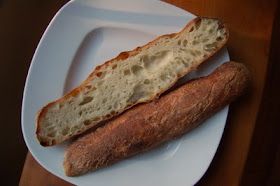 Here is my first pathetic attempt at a baguette. The only thing that makes me feel better about this disaster is that most people's first attempt at a baguette is pretty pathetic. Even though both Steve and Jason suggested that any aspiring bread baker should bake nothing but baguettes for some time, I was staying away from this most basic of all breads like the plague. You can judge a cook by his roast chicken and a baker by his baguette. In spite of their simplicity, they'll spell every weakness you have in bold print.
Here is my first pathetic attempt at a baguette. The only thing that makes me feel better about this disaster is that most people's first attempt at a baguette is pretty pathetic. Even though both Steve and Jason suggested that any aspiring bread baker should bake nothing but baguettes for some time, I was staying away from this most basic of all breads like the plague. You can judge a cook by his roast chicken and a baker by his baguette. In spite of their simplicity, they'll spell every weakness you have in bold print. The fact that you are looking at a picture of a baguette wannabe is a bit of an accident. I was trying to make a boule using Anis's formula again, but was running late and didn't have sufficient time to bake and cool a boule before dinner. So I thought why not give a baguette a try. The bad news is that they were pretty bad. The good news is that I have some ideas as to why.
What I did
500g flour (half ap, half bread)
1 2/3 cup water
4 tsp DCK
1/4 tsp yeast
kneaded by hand for 20 minutes. Allowed for rise at room temp for 12-14 hours with 3 folds. refrigerated for another 8 hours. divided, rested 15 min, shaped, proofed 45 min on parchment, baked at 475 (preheating to 500) for 22 minutes (first 10 with steam).
Flavor
No sweetness this time. A long rise at room temp is the culprit. What I got was kind of Bittman's no-knead formula with no-knead rising schedule, plus kneading. I found the explanation to my problem in Reinhart's Pain a l'Ancienne recipe that is incredibly similar in concept to Anis's. Here is what he writes: "The cold mixing and fermentation cycles delay the activation of the yeast until after the amylase enzymes have begun their work of breaking out sugar from the starch. When the dough is brought to room temperature and the yeast wakes up and begins feasting, it feeds on sugars that weren't there the day before. Because the yeast has converted less of the released sugar to alcohol and carbon dioxide, a reserve of sugar remains in the fermented dough to flavor it and caramelize the crust during the baking cycle."
Texture
Too dense in parts, uneven holes. My terrible shaping and slashing might have something to do with this. I was proofing on parchment so they spread out a lot. Really need to get some canvas. I might have over steamed them during proof. Since it was so cold and dry, I put 2 little bowl of boiling water into the proof box. That was probably an over kill. The top was so wet, it was hard to slash. The use of bread flour was also a mistake -- it made them much harder to stretch out. From what I've read, this bread is supposed to rely on the oven spring. The question is how do you get it? They puffed up in the oven some, but didn't open nicely at the slashes. I am guessing I didn't proof them long enough. My kitchen is too cold for a 45 minute proof right now. I also never know how much to de-gas before shaping. The bubbles left over from the fermentation kept popping up, making it difficult to shape.

That's not a pathetic attempt at all! Not attempting to make it would qualify for pathetic, but you rolled up your sleeves and gave it a go! Will be improved next time....
ReplyDeleteSounds interesting!
ReplyDeleteI proof my winter bread in the basement, near the heater...and if I am doing wash at the same time, there is some lovey humidity for it as well!
ReplyDeleteThat's a great idea, Christine!
ReplyDeleteHello,
ReplyDeleteWhat is DCK?
Thanks
SB
DCK is my abbreviation for Diamond Crystal Kosher salt.
ReplyDelete